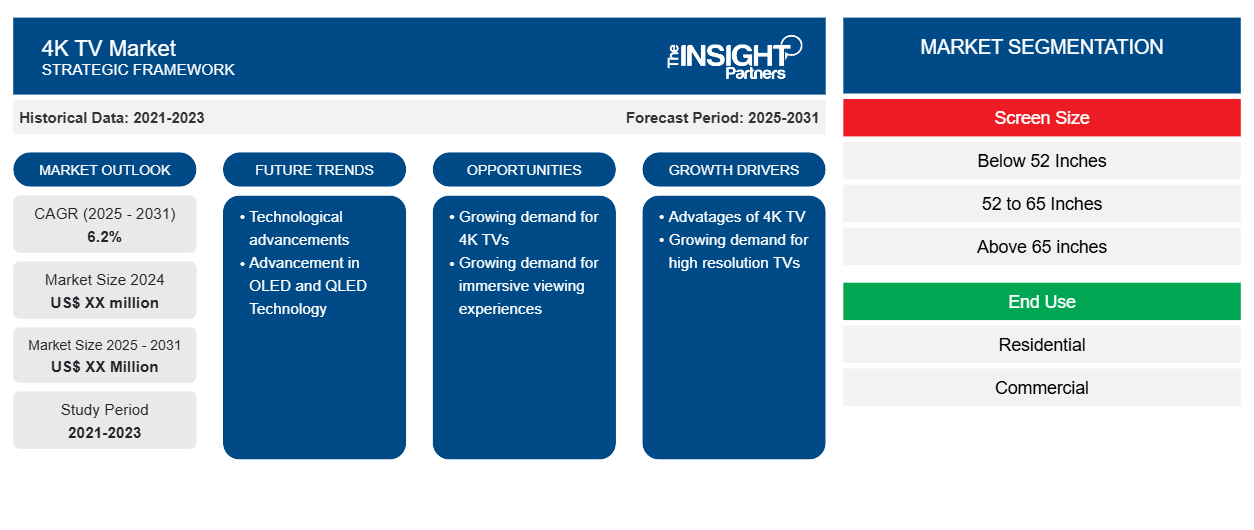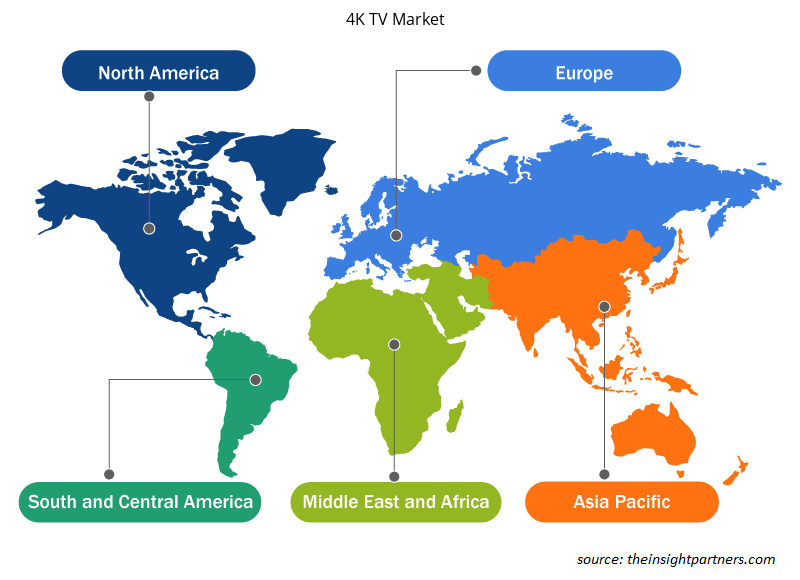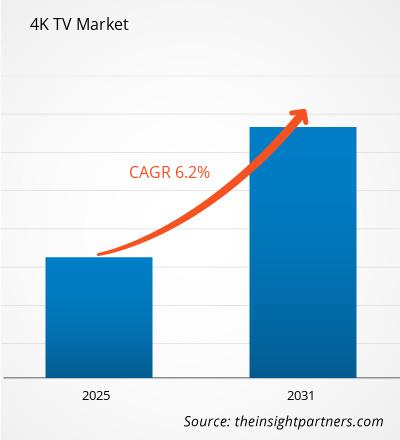The 4K TV Market is expected to register a CAGR of 6.2% from 2025 to 2031, with a market size expanding from US$ XX million in 2024 to US$ XX Million by 2031.
The Report is Segmented by Screen Size (Below 52 Inches, 52 to 65 Inches, Above 65 inches), End Use (Residential, Commercial). The global analysis is further broken-down at regional level and major countries. The report offers the value in USD for the above analysis and segments
Purpose of the Report
The report 4K TV Market by The Insight Partners aims to describe the present landscape and future growth, top driving factors, challenges, and opportunities. This will provide insights to various business stakeholders, such as:
- Technology Providers/Manufacturers: To understand the evolving market dynamics and know the potential growth opportunities, enabling them to make informed strategic decisions.
- Investors: To conduct a comprehensive trend analysis regarding the market growth rate, market financial projections, and opportunities that exist across the value chain.
- Regulatory bodies: To regulate policies and police activities in the market with the aim of minimizing abuse, preserving investor trust and confidence, and upholding the integrity and stability of the market.
4K TV Market Segmentation
Screen Size
- Below 52 Inches
- 52 to 65 Inches
- Above 65 inches
End Use
- Residential
- Commercial
You will get customization on any report - free of charge - including parts of this report, or country-level analysis, Excel Data pack, as well as avail great offers and discounts for start-ups & universities
4K TV Market: Strategic Insights

- Get Top Key Market Trends of this report.This FREE sample will include data analysis, ranging from market trends to estimates and forecasts.
4K TV Market Growth Drivers
- Advatages of 4K TV: The biggest advantage of 4K TVs is enhanced picture quality. With four times as many pixels as a typical HD screen, the image is more crisper, clearer, and more detailed. Another advantage of 4K TVs is that they allow to acquire a greater screen size without sacrificing image quality.The image quality of a conventional HD screen degrades with increasing screen size. Thus, the demand for 4K TV is expected to grow during the forecast period.
- Growing demand for high resolution TVs: 4K TV resolution has emerged as the peak of visual technology in recent years. As the demand for high-definition viewing experiences grows, 4K grade TVs have grown in favor among customers, owing to their astounding clarity and deep detail, which distinguish them from other standard resolutions. Thus, the demand for 4K TV is expected to grow during the forecast period.
4K TV Market Future Trends
- Technological advancements: Key market partcipants are focusing on product development in the 4K TV market. For instance, Sony India ,launched its BRAVIA 2 range of 4K Ultra HD TVs in May 2024, which is compatible with Google TV. The TV is equipped with a new X1 processor, which is supposed to improve the watching experience by providing a high contrast ratio and greater picture quality to Indian consumers. The TV is also PS5 compatible, meeting the needs of gamers in the country.
- Advancement in OLED and QLED Technology: OLED and QLED technologies are becoming more popular in 4K TVs due to their superior picture quality, deeper blacks, and more vibrant colors. These advancements offer better contrast, brightness, and color accuracy, making them a preferred choice for high-end 4K TV buyers.
4K TV Market Opportunities
- Growing demand for 4K TVs: A 4K TV is a television with 4K resolution. That means the TV has 3,840 horizontal and 2,160 vertical pixels, for a total of approximately 8.3 million pixels. Resolutions for 4K TVs are typically listed as "3840 x 2160" in device specifications. 4K TVs contain four times as many pixels as regular Full HD (1920 x 1080) TVs. Even on TV displays of the same size, the 4K TV picture quality ends up being more colorful and detailed because of the increased pixel density. Thus, the demand for 4K TV is expected to boost during the forecast period.
- Growing demand for immersive viewing experiences:One big opportunity for the 4K TV market is the increasing demand for immersive watching experiences, which is being driven by advances in streaming technology and content availability. As more platforms, such as Netflix, Amazon Prime, and Disney+, increase their 4K video libraries, consumers demand higher-quality televisions.
4K TV Market Regional Insights
The regional trends and factors influencing the 4K TV Market throughout the forecast period have been thoroughly explained by the analysts at Insight Partners. This section also discusses 4K TV Market segments and geography across North America, Europe, Asia Pacific, Middle East and Africa, and South and Central America.

- Get the Regional Specific Data for 4K TV Market
4K TV Market Report Scope
| Report Attribute | Details |
|---|---|
| Market size in 2024 | US$ XX million |
| Market Size by 2031 | US$ XX Million |
| Global CAGR (2025 - 2031) | 6.2% |
| Historical Data | 2021-2023 |
| Forecast period | 2025-2031 |
| Segments Covered |
By Screen Size
|
| Regions and Countries Covered | North America
|
| Market leaders and key company profiles |
4K TV Market Players Density: Understanding Its Impact on Business Dynamics
The 4K TV Market is growing rapidly, driven by increasing end-user demand due to factors such as evolving consumer preferences, technological advancements, and greater awareness of the product's benefits. As demand rises, businesses are expanding their offerings, innovating to meet consumer needs, and capitalizing on emerging trends, which further fuels market growth.
Market players density refers to the distribution of firms or companies operating within a particular market or industry. It indicates how many competitors (market players) are present in a given market space relative to its size or total market value.
Major Companies operating in the 4K TV Market are:
- LG Electronics, Inc.
- Hisense Corporation Limited
- Vu Technologies Pvt. Ltd.
- Sony Corporation
- Sharp Corporation
- Asus Tek Corporation
Disclaimer: The companies listed above are not ranked in any particular order.

- Get the 4K TV Market top key players overview
Key Selling Points
- Comprehensive Coverage: The report comprehensively covers the analysis of products, services, types, and end users of the 4K TV Market, providing a holistic landscape.
- Expert Analysis: The report is compiled based on the in-depth understanding of industry experts and analysts.
- Up-to-date Information: The report assures business relevance due to its coverage of recent information and data trends.
- Customization Options: This report can be customized to cater to specific client requirements and suit the business strategies aptly.
The research report on the 4K TV Market can, therefore, help spearhead the trail of decoding and understanding the industry scenario and growth prospects. Although there can be a few valid concerns, the overall benefits of this report tend to outweigh the disadvantages.
Frequently Asked Questions
What are the deliverable formats of the market report?
The report can be delivered in PDF/PPT format; we can also share excel dataset based on the request
What are the options available for the customization of this report?
Some of the customization options available based on the request are an additional 3-5 company profiles and country-specific analysis of 3-5 countries of your choice. Customizations are to be requested/discussed before making final order confirmation# as our team would review the same and check the feasibility
What are the future trends of the 4K TV market?
Technological advancements to play a significant role in the global 4K TV market in the coming years
What is the expected CAGR of the 4K TV market
The 4K TV Market is estimated to witness a CAGR of 6.2% from 2023 to 2031
What are the driving factors impacting the global 4K TV market?
Advatages of 4K TV and growing demand for high resolution TVs are the major factors driving the 4K TV market
- Historical Analysis (2 Years), Base Year, Forecast (7 Years) with CAGR
- PEST and SWOT Analysis
- Market Size Value / Volume - Global, Regional, Country
- Industry and Competitive Landscape
- Excel Dataset
Testimonials
I wish to appreciate your support and the professionalism you displayed in the course of attending to my request for information regarding to infectious disease IVD market in Nigeria. I appreciate your patience, your guidance, and the fact that you were willing to offer a discount, which eventually made it possible for us to close a deal. I look forward to engaging The Insight Partners in the future, all thanks to the impression you have created in me as a result of this first encounter.
DR CHIJIOKE ONYIA, MANAGING DIRECTOR, PineCrest Healthcare Ltd.The Insight Partners delivered insightful, well-structured market research with strong domain expertise. Their team was professional and responsive throughout. The user-friendly website made accessing industry reports seamless. We highly recommend them for reliable, high-quality research services
Yukihiko Adachi CEO, Deep Blue, LLC.Reason to Buy
- Informed Decision-Making
- Understanding Market Dynamics
- Competitive Analysis
- Customer Insights
- Market Forecasts
- Risk Mitigation
- Strategic Planning
- Investment Justification
- Identifying Emerging Markets
- Enhancing Marketing Strategies
- Boosting Operational Efficiency
- Tracking Industry Innovations
- Aligning with Regulatory Trends
Yes! We provide a free sample of the report, which includes Report Scope (Table of Contents), report structure, and selected insights to help you assess the value of the full report. Please click on the "Download Sample" button or contact us to receive your copy.
Absolutely — analyst assistance is part of the package. You can connect with our analyst post-purchase to clarify report insights, methodology or discuss how the findings apply to your business needs.
Once your order is successfully placed, you will receive a confirmation email along with your invoice.
• For published reports: You’ll receive access to the report within 4–6 working hours via a secured email sent to your email.
• For upcoming reports: Your order will be recorded as a pre-booking. Our team will share the estimated release date and keep you informed of any updates. As soon as the report is published, it will be delivered to your registered email.
We offer customization options to align the report with your specific objectives. Whether you need deeper insights into a particular region, industry segment, competitor analysis, or data cut, our research team can tailor the report accordingly. Please share your requirements with us, and we’ll be happy to provide a customized proposal or scope.
The report is available in either PDF format or as an Excel dataset, depending on the license you choose.
The PDF version provides the full analysis and visuals in a ready-to-read format. The Excel dataset includes all underlying data tables for easy manipulation and further analysis.
Please review the license options at checkout or contact us to confirm which formats are included with your purchase.
Our payment process is fully secure and PCI-DSS compliant.
We use trusted and encrypted payment gateways to ensure that all transactions are protected with industry-standard SSL encryption. Your payment details are never stored on our servers and are handled securely by certified third-party processors.
You can make your purchase with confidence, knowing your personal and financial information is safe with us.
Yes, we do offer special pricing for bulk purchases.
If you're interested in purchasing multiple reports, we’re happy to provide a customized bundle offer or volume-based discount tailored to your needs. Please contact our sales team with the list of reports you’re considering, and we’ll share a personalized quote.
Yes, absolutely.
Our team is available to help you make an informed decision. Whether you have questions about the report’s scope, methodology, customization options, or which license suits you best, we’re here to assist. Please reach out to us at sales@theinsightpartners.com, and one of our representatives will get in touch promptly.
Yes, a billing invoice will be automatically generated and sent to your registered email upon successful completion of your purchase.
If you need the invoice in a specific format or require additional details (such as company name, GST, or VAT information), feel free to contact us, and we’ll be happy to assist.
Yes, certainly.
If you encounter any difficulties accessing or receiving your report, our support team is ready to assist you. Simply reach out to us via email or live chat with your order information, and we’ll ensure the issue is resolved quickly so you can access your report without interruption.















The List of Companies
1. Changhong
2. Haier Inc.
3. Hisense International Co. LTD
4. LG Electronics
5. Panasonic Corporation
6. Samsung Electronics Co. Ltd.
7. Sharp Corporation
8. Sony Corporation
9. Toshiba Corporation
10. VIZIO Inc.






 Get Free Sample For
Get Free Sample For